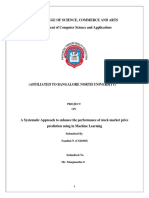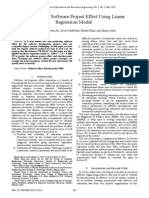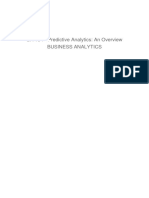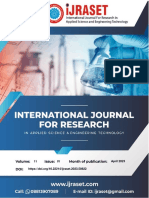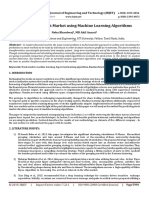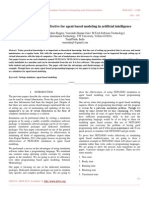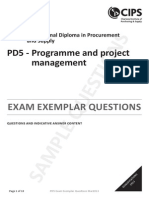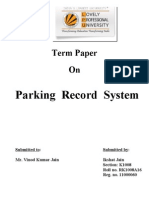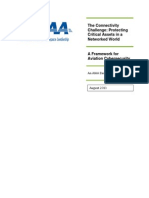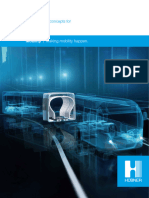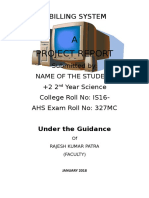Professional Documents
Culture Documents
Profit Forecasting of Automotive and Component Sub Sector Companies Using Monte Carlo Simulation
Copyright
Available Formats
Share this document
Did you find this document useful?
Is this content inappropriate?
Report this DocumentCopyright:
Available Formats
Profit Forecasting of Automotive and Component Sub Sector Companies Using Monte Carlo Simulation
Copyright:
Available Formats
Volume 7, Issue 12, December – 2022 International Journal of Innovative Science and Research Technology
ISSN No:-2456-2165
Profit Forecasting of Automotive and Component Sub
Sector Companies using Monte Carlo Simulation
Nandha Sekar Pratiwi Nurafni Eltivia Nur Indah Riwajanti
Accounting Department Accounting Department Accounting Department
Politeknik Negeri Malang Politeknik Negeri Malang Politeknik Negeri Malang
Malang, Indonesia Malang, Indonesia Malang, Indonesia
Abstract:- This objective of this study is to forecast the simulation depends on the number of experiments carried out,
profit of automotive and component sub sector and the random numbers generated.
companies using a monte carlo simulation with R
Program. The data used are profit per quarter from 2019 The purpose of this research is to forecast the profit of
to 2021 of five automotive and component sub sector automotive and component sub sector companies using a
companies listed on IDX. The method use in this study is Monte Carlo simulation. The selected companies are listed on
the monte carlo simulation. This method uses a IDX. Monte Carlo simulation is a pattern using random
probabilistic approach so that it is able to consider number, namely random variable used to solve stochastic and
uncertainty. The result of profit forecasting in 2022 to deterministic problem, the time does not play the real role.
2024 for PT Astra Internasional Tbk is IDR 62,275 Generally Monte Carlo simulation is mor static rather than
trillion, PT Garuda Metalindo Tbk is IDR 53,594 billion, dynamic [4]. The probabilistic approach is able to consider
PT Gajah Tunggal Tbk is IDR 711,669 billion, PT the uncertainties that may occur. In addition, this method is
Indomobil Sukses Internasional Tbk is IDR 826,315 quite simple in describing and solving problems. The
billion, and PT Indospring Tbk is IDR 253,959 billion. simulation is run using Microsoft Excel and the RStudio
program.
Keywords:- Forecasting, Monte Carlo Simulation, R
Program. II. LITERATURE REVIEW
I. INTRODUCTION A. Forecasting
Forecasting is a technique that uses historical data to
Forecasting is a technique that uses historical data to systematically estimate what the future holds [1]. Forecasting
systematically estimate what the future holds. In business is a basic input in operations management’s decision-making
practices such as companies, predictions of future conditions proceess because forecasting provides information on future
are often carried out because business predictions are needed demand [5]. The forecast predicts what will happen, but it is
by almost all economic entities. Profit forecasting can show not certain that the company can implement it [6].
financial hazard signals, assess the company's performance
and provide information related to the survival of an According to reference [7], there are five forecasting
enterprise [1]. principles that need to be considered to get good forecasting
results:
Research on profit forecasting using monte carlo Forecasts always contain errors. Forecasting reduces the
simulation was conducted by Petru Balogh [2]. In factor of uncertainty but can never eliminate it.
determining the probability distribution, cumulative The forecast must include a measure of error. The
probability distribution, random numbers, and profit magnitude of the error can be expressed in terms of a
forecasting, Balogh's research uses Microsoft Excel. The range around the forecast result either in units or as a
research conducted by Balogh is similar to what will be percentage and the probability that actual demand will fall
carried out, which is also about profit forecasting using within that range..
Monte Carlo simulations. However, in determining the Grouped item forecasting is always more accurate than
probability distribution, cumulative probability distribution, item-by-item forecasting.
random numbers, and profit forecasting, this research will use Forecasting for the short term is always more accurate
the R Program. than forecasting for the long term. In the short term,
conditions affecting demand tend to remain
Another study on Monte Carlo simulations was constant/change slowly, so short term forecasts tend to be
conducted by Zulfiqar Busrah regarding forecasting changes more accurate.
in stock prices [3]. Busrah's research is more focused than If possible, it is better to estimate the number of requests
Balogh's because the forecasting process using simulation is based on calculations rather than forecast results.
carried out in 30 iterations. Based on the results obtained, it
can be explained that the difference between theory and
IJISRT22DEC1467 www.ijisrt.com 1986
Volume 7, Issue 12, December – 2022 International Journal of Innovative Science and Research Technology
ISSN No:-2456-2165
B. Simulation D. R Program
Simulation is a numerical technique to do an experiment R is a multi-paradigm statistical programming
in computer involving a certain mathematical and logical language, based on the S statistical language developed in the
model displaying business characteristic and economic 1990s by Ross Ihaka and Robert Gentleman at the University
system in a long time period [4]. In the simulation, a computer of Auckland, New Zealand [9]. R software is integrated with
is used to study the system numerically, where data is RStudio. If analogous to a vehicle, R is the engine and
collected to perform statistical estimations to obtain the RStudio is the outer shell of the car and its interior. Both are
original characteristics of the system. Simulation is a great open source and free. RStudio is widely used by data analysts
tool to use, especially when it is necessary to conduct and researchers because this software is equipped with
experiments to find the best comments from system various practical additional features that make it easier to use.
components. This is because the cost is very expensive and The advatages of using R according to reference by [10] is as
requires a long time if the experiment is carried out in real follow:
terms. By conducting simulation studies, the right decisions R is a free, open source computer language and software
can be taken in a short time and at a low cost because environment for statistical computing and graphics.
everything is done by a computer. The simulation approach In addition to data sharing, open access to R codes will
begins with building a real system model. The model must be facilitate reproduction and replication of data analysis.
able to show how the various components in the system Statisticians and computer scientists have developed
interact so that it truly describes the behavior of the system. thousands of R packages. These packages can be used for
After the model is created, it converted into a computer conducting nearly any analysis imaginable.
program so that it is possible to simulate it. R have an ability to produce high-quality graphics.
Because R is a command line driven language, the
C. Monte Carlo Simulation researcher specifies graphic elements with code.
Monte Carlo simulation refers to a computerized R is a programming language, rendering the range of
mathematical technique that provides a range of possible possible uses and functions nearly unlimited. Its
outcomes and their probabilities of occurrence, given specific flexibility enables ideas suggested by a community
input ranges and probabilities [8]. Monte Carlo simulation is professional statisticians and computer scientists to be
a pattern using random number, namely random variable used integrated almost instantaneously.
to solve stochastic and deterministic problem, the time does R can be used with MYSQL database and Apache web-
not play the real role [4]. Monte Carlo simulation is server, which facilitates the development of innovative
categorized as a sampling method because the inputs are online programs or platforms.
randomly generated from probability distributions to simulate
R can be used to analyze corpus data using natural
the process of sampling from an actual population In a Monte language processing packages.
Carlo simulation, the model is built based on the actual
system [2]. Each variable in the model has a value that has a
III. METHODOLOGY
different probability, which is shown by the probability
distribution or commonly called the probability distribution
The object of this research are five automotive and
function of each variable. The Monte Carlo method simulates component sub sector companies listed on IDX. The
the system repeatedly, hundreds or even thousands of times companies are PT Astra Internasional Tbk, PT Garuda
depending on the system under consideration, by selecting a Metalindo Tbk, PT Gajah Tunggal Tbk, PT Indomobil
random value for each variable from its probability Sukses Internasional Tbk, and PT Indospring Tbk.
distribution. The results obtained from the simulation are in
the form of a probability distribution of the value of a system This is a quantitative research. This research will be
as a whole. Monte Carlo simulation has been applied to conducted using Microsoft Excel and the R Program to run a
various fields including project management, transportation,
Monte Carlo simulation to obtain profit forecasts for the five
computer design, finance, meteorology, biology and automotive and component sub sector companies listed on
biochemistry. IDX. In this research, the source of data needed and used is
secondary data. The data used in this research is profit per
quarter from 2019 to 2021. The profit data used is accessed
from https://www.idx.co.id/ which has prepared Financial
Statements for the last few years.
The following table is profit data for automotive and
component sub sector companies:
IJISRT22DEC1467 www.ijisrt.com 1987
Volume 7, Issue 12, December – 2022 International Journal of Innovative Science and Research Technology
ISSN No:-2456-2165
TABLE I. PROFIT (LOSS) DATA FOR AUTOMOTIVE AND COMPONENT SUB SECTOR COMPANIES
Profit (Loss) (IDR)
Year ASII BOLT GJTL IMAS INDS
(in billion) (in million) (in million) (in million) (in million)
2019
Q1 6,665 28,045 168,959 655,074 22,625
Q2 5,636 (7,918) (5,200) (194,102) 763
Q3 7,327 29,243 (24,228) (122,971) 16,825
Q4 6,993 2,122 129,576 (216,232) 61,252
2020
Q1 5,687 11,230 (404,182) (185,591) 43,125
Q2 7,450 (21,727) 263,038 (218,220) (16,725)
Q3 3,096 (11,177) 36,548 946,033 8,740
Q4 2,338 (35,714) 423,510 (1,217,932) 23,611
2021
Q1 4,657 20,608 113,277 (64,313) 48,385
Q2 6,486 1,410 (17,474) 116,616 41,002
Q3 7,875 21,314 (80,280) (145,731) 54,812
Q4 6,568 39,417 64,373 (161,912) 14,000
Source: IDX, 202
Data processing uses Monte Carlo Simulation to obtain Then calculate the probability distribution:
forecasting results. Forecasting is done for 12 quarters or 3
years in the future. The following steps are: prob.dist = freq/sum(freq)
prob.dist
Determine the probability distribution of total profit.
The results of calculating the overall probability
The formula is: distribution can be seen in table 2.
P = F/T
TABLE II. PROFIT PROBABILITY DISTRIBUTION FOR 2020-
Description: 2021
P : the nth probability distribution Year ASII BOLT GJTL IMAS INDS
F : frequency (number of sales in period n)
2019
T : total (total sales amount)
1. Determine the cumulative probability distribution. Q1 0.0942 0.1220 0.0976 0.1543 0.0643
2. Determine the random number intervals. Q2 0.0796 0.0344 0.0030 0.0457 0.0022
3. Random number generation. Q3 0.1035 0.1272 0.0140 0.0290 0.0478
4. Perform forecasting using simulation procedures. Q4 0.0988 0.0092 0.0749 0.0509 0.1741
2020
IV. RESULTS AND DISCUSSION
Q1 0.0803 0.0488 0.2335 0.0437 0.1226
A. Determine the Probability Distribution of Total Profit Q2 0.1053 0.0945 0.1520 0.0514 0.0475
The calculation of determining the probability Q3 0.0437 0.0486 0.0211 0.2229 0.0248
distribution is carried out for each profit in each quarter. An Q4 0.0330 0.1553 0.2447 0.2869 0.0671
example of calculating the probability distribution in the first 2021
quarter of 2019 is as follows:
Q1 0.0658 0.0896 0.0655 0.0152 0.1375
𝐹 6,665 Q2 0.0916 0.0061 0.0101 0.0275 0.1165
P(Q1 2019) = = = 0.0942
𝑇 70,778 Q3 0.1113 0.0927 0.0464 0.0343 0.1558
Q4 0.0928 0.1714 0.0372 0.0381 0.0398
The probability distribution calculation does not need to
be done manually one by one. If using RStudio, the first thing Total 1.0000 1.0000 1.0000 1.0000 1.0000
to do is enter and call data into R. As an example the data Source: Data Proceed, 2022
used is the profit of PT Astra International Tbk.
Table 2 shows the calculation of the results of the
mid.point = c(2569, 2800, 3263, 3725, 4188, 4650, 5113, probability distribution or opportunity value that will be
5575, 6037, 6500, 6962, 7425) substituted for the frequency of occurrence of each variable.
freq = c(6665, 5636, 7327, 6993, 5687, 7450, 3096, 2338, For example, the calculation results in the first quarter of
4657, 6486, 7875, 6568) ASII in 2019 obtained a probability distribution value of
0.0942 and in the second quarter a value of 0.0796 was
obtained.
IJISRT22DEC1467 www.ijisrt.com 1988
Volume 7, Issue 12, December – 2022 International Journal of Innovative Science and Research Technology
ISSN No:-2456-2165
B. Determine the Cumulative Probability Distribution The results of calculating the overall cumulative
The calculation of the cumulative probability probability distribution can be seen in table 3. Table 3 is the
distribution is the summation of the probability distribution result of the calculation of the cumulative probability
of a particular variable with the previous variable, except for distribution. For example, the calculation of the cumulative
the first variable. The formula used is on RStudio is as probability distribution in the second quarter of ASII in 2019
follows: is the result of the sum of the value of the probability
distribution in the first quarter and second quarter of 0.0942
cum.dist=cumsum(prob.dist) + 0.0796. The calculation results from table 3 will be used as
cum.dist a guide in determining the interval of random numbers.
TABLE III. CUMULATIVE PROBABILITY DISTRIBUTION OF PROFIT FOR 2019-2021
Year ASII BOLT GJTL IMAS INDS
2019
Q1 0.0942 0.1220 0.0976 0.1543 0.0643
Q2 0.1738 0.1564 0.1006 0.2001 0.0665
Q3 0.2773 0.2836 0.1146 0.2290 0.1143
Q4 0.3761 0.2928 0.1895 0.2800 0.2884
2020
Q1 0.4565 0.3417 0.4230 0.3237 0.4109
Q2 0.5617 0.4362 0.5750 0.3751 0.4585
Q3 0.6055 0.4848 0.5962 0.5980 0.4833
Q4 0.6385 0.6401 0.8409 0.8849 0.5504
2021
Q1 0.7043 0.7297 0.9063 0.9001 0.6879
Q2 0.7959 0.7359 0.9164 0.9275 0.8044
Q3 0.9072 0.8286 0.9628 0.9619 0.9602
Q4 1.0000 1.0000 1.0000 1.0000 1.0000
Source: Data Proceed, 2022
C. Determine the Random Number Intervals
The calculation of random number intervals is used to find the limiting value that is the minimum and maximum. Table 4
describes the intervals of random numbers of each profit. The results of the random number interval will be used as a guide in carrying
out the simulation process to produce forecasting results.
TABLE IV. PROFIT RANDOM NUMBER INTERVAL FOR 2019-2021
ASII BOLT GJTL IMAS INDS
F Interval F Interval F Interval F Interval F Interval
2,569 0-0.09 -32,584 0-0.12 -369,695 0-0.09 -1,127,767 0-0.15 -13,476 0-0.05
3,031 0-1-0.17 -26,322 0.13-0.15 -300,720 0.097-0.1 -947,435 0.16-0.2 -6,977 0.05-0.06
3,494 0-18-0.27 -20,060 0.16-0.28 -231,744 0.11-0.12 -767,104 0.21-0.22 -478 0.07-0.11
3,956 0.28-0.37 -13,798 0.29-0.30 -162,769 0.13-0.18 -586,773 0.23-0.28 6,021 0.12-0.28
4,418 0.38-0.45 -7,536 0.31-0.34 -93,794 0.19-0.42 -406,441 0.29-0.32 12,520 0.29-0.41
4,649 0.46-0.56 -1,274 0.35-0.43 -24,818 0.43-0.57 -226,110 0.33-0.37 19,019 0.42-0.45
5,112 0.57-0.6 4,988 0.44-0.48 44,157 0.58-0.59 -45,778 0.38-0.59 25,519 0.46-0.48
5,574 0.61-0.63 11,250 0.49-0.64 113,133 0.6-0.84 134,553 0.6-0.88 32,018 0.49-0.55
6,037 0.64-0.7 17,512 0.65-0.72 182,108 0.85-0.9 314,885 0.89-0.9 38,517 0.56-0.68
6,500 0.71-0.79 23,774 0.73-0.74 251,083 0.91-0.92 495,216 0.91-0.92 45,016 0.69-0.8
6,962 0.8-0.9 30,036 0.75-0.82 320,059 0.93-0.96 675,547 0.93-0.96 51,515 0.81-0.96
7,425 0.91-1.0 36,298 0.83-1.0 389,034 0.97-1.0 855,879 0.97-1.0 58,014 0.97-1.0
Source: Data Proceed, 2022
D. Random Number Generation
The formula used in R Program to generate random numbers is as follows:
U=runif(12) #as simulated for the next 12 quarters (3 years)
U
IJISRT22DEC1467 www.ijisrt.com 1989
Volume 7, Issue 12, December – 2022 International Journal of Innovative Science and Research Technology
ISSN No:-2456-2165
The overall result of the generation of random numbers can be seen in table 5.
TABLE V. RANDOM NUMBER GENERATION FOR 2022-2024
Random Number
Year
ASII BOLT GJTL IMAS INDS
2022
Q1 0.8775 0.2649 0.0520 0.2108 0.6940
Q2 0.7685 0.0695 0.7991 0.0716 0.9864
Q3 0.2789 0.9071 0.1269 0.3204 0.3452
Q4 0.5291 0.9922 0.7074 0.9373 0.4491
2023
Q1 0.9629 0.0640 0.5300 0.8014 0.8845
Q2 0.9803 0.6751 0.8974 0.7385 0.4072
Q3 0.9133 0.3309 0.0379 0.9693 0.9340
Q4 0.0707 0.4478 0.5283 0.4790 0.9939
2024
Q1 0.3275 0.8341 0.5858 0.2669 0.9876
Q2 0.3700 0.1859 0.9468 0.5738 0.9476
Q3 0.7155 0.5112 0.8033 0.9961 0.0058
Q4 0.7577 0.4749 0.1928 0.2235 0.0724
Source: Data Proceed, 2022
E. Perform Forecasting Using Simulation Procedures
Profit forecasting is carried out from 2019 to 2021. Monte carlo simulation experiment using two random number generation or
two iterations. The results of profit forecasting with monte carlo simulation can be seen in table 6. Table 6 describes the results of
profit distribution in 5 automotive and component sub-sector companies using monte carlo simulations. From the forecasting results,
it was obtained that the total profit forecasting for three years of ASII is IDR 62,275 trillion, BOLT is IDR 53,594 billion, GJTL is
IDR 711,669 billion, IMAS is IDR 826,315 billion, and INDS is IDR 253,959 billion.
TABLE VI. PROFIT FORECASTING RESULTS BASED ON MONTE CARLO SIMULATION 2022-2024
Profit (Loss) Forecast (IDR)
Year ASII BOLT GJTL IMAS INDS
(in billion) (in million) (in million) (in million) (in million)
2022
Q1 6,962 -13,798 -36,9695 -947,435 -748
Q2 6,500 -26,322 11,3133 -112,776 6,021
Q3 3,725 36,298 -36,9695 -767,104 6,021
Q4 4,650 36,298 11,3133 855,879 58,014
2023
Q1 7,425 -32,584 -24,818 675,547 6,021
Q2 7,425 23,774 182,108 675,547 6,021
Q3 2,569 -13,798 -369,695 855,879 38,517
Q4 2,569 4,988 -24,818 134,553 38,517
2024
Q1 3,725 36,298 44,157 -947,435 38,517
Q2 3,725 -20,060 251,083 495,216 19,019
Q3 6,500 11,250 113,133 855,879 51,515
Q4 6,500 11,250 -369,695 -947,435 -13,476
Source: Data Proceed, 2022
Based on the table of profit (loss) forecast results, a chart plot(profit_prediction_table1, xlab="Quarter", ylab="Profit
will be made as in Figure 1, Figure 2, Figure 3, Figure 4 and Prediction", type="o", col="blue")%/%
Figure 5. The formula used to surface the graph is as follows: lines(profit_prediction_table2, type="o", pch=21,
col="red")%/%
title(main=”Profit Forecasting 2022-2024", col.main="red",
font.main=4)
IJISRT22DEC1467 www.ijisrt.com 1990
Volume 7, Issue 12, December – 2022 International Journal of Innovative Science and Research Technology
ISSN No:-2456-2165
The picture below is a chart for profit forecasting from PT
Astra Internasional Tbk, PT Garuda Metalindo Tbk, PT Gajah
Tunggal Tbk, PT Indomobil Sukses Internasional Tbk, and PT
Indospring Tbk for 2022 to 2024.
Fig. 5. INDS Profit Forecasting for 2022-2024
V. CONCLUSION
Based on the results of data processing, it can be concluded
Fig. 1. ASII Profit Forecasting for 2022-2024 that the results of profit forecasting for five automotive and
component sub-sector companies using monte carlo simulations
for 2022 to 2024 are as follows. Profit forecasting for PT Astra
Internasional Tbk is IDR 62,275 trillion, PT Garuda Metalindo
Tbk is IDR 53,594 billion, PT Gajah Tunggal Tbk is IDR
711,669 billion, PT Indomobil Sukses Internasional Tbk is IDR
826,315 billion, and PT Indospring Tbk is IDR 253,959 billion.
These results can provide information to the company to
evaluate the production and sales planning that will be carried
out so that the fulfillment of demand and also the expected profit
can be met and consumer satisfaction will increase.
REFERENCES
Fig. 2. BOLT Profit Forecasting for 2022-2024 [1]. I. Admirani, “Penerapan Metode Fuzzy Time Series Untuk
Prediksi Laba Pada Perusahaan.” Jurnal JUPITER, vol.
10, no. 1, 2018, p. 13.
[2]. P. Balogh, P. Golea, and V. Inceu, “Profit Forecast Model
Using Monte Carlo Simulation in Excel.” Romanian
Statistical Review, vol. 12, 2013, pp. 33–40.
[3]. Z. Busrah and B. Asrun, “Simulasi Monte Carlo Pada
Penentuan Perubahan Harga Saham ADHI.JK melalui
Pendekatan Proses WIENER Dan LEMMA ITÔ.”
Prosiding Seminar Nasional, vol. 02, no. 1, 2016, pp. 807–
16.
[4]. H. Ramadan, P.U. Gio, and E. Rosmaini, “Monte Carlo
Simulation Approach to Determine the Optimal Solution
of Probabilistic Supply Cost.” Journal of Research in
Fig. 3. GJTL Profit Forecasting for 2022-2024 Mathematics Trends and Technology, vol. 2, no. 1, Feb.
2020, pp. 1–6.
[5]. J. Heizer and B. Render, “Operations Management
Sustainability and Supply Chain Management Eleventh
Edition”, United States: Pearson Education, Inc. Thing.
136, 2011.
[6]. P. Fridhayanti, N. Eltivia, and N.I. Riwajanti, “Impact of
Pandemic on Online Marketplace Active Users:”
Advances in Economics, Business and Management
Research, vol. 183, 2021, pp. 250–253.
[7]. H. Ramadan, P.U. Gio, and E. Rosmaini, “Monte Carlo
Simulation Approach to Determine the Optimal Solution
of Probabilistic Supply Cost” Journal of Resarch in
Mathematics Trends and Technology, vol. 2, pp. 1-6,
2020.
Fig. 4. IMAS Profit Forecasting for 2022-2024
IJISRT22DEC1467 www.ijisrt.com 1991
Volume 7, Issue 12, December – 2022 International Journal of Innovative Science and Research Technology
ISSN No:-2456-2165
[8]. M. Crum and C. Rayhorn, “Using Monte Carlo Simulation
for Pro Forma Financial Statements.” Journal of
Accounting and Finance, vol. 19, no. 5, Sept. 2019, pp.
29–40.
[9]. M. Vidoni, “Software Engineering and R Programming: A
Call for Research.” The R Journal, vol. 13, no. 2, 2021, p.
600.
[10]. A. Mizumoto and L. Plonsky. “R as a Lingua Franca:
Advantages of Using R for Quantitative Research in
Applied Linguistics.” Applied Linguistics, vol. 37, no. 2,
Apr. 2016, pp. 284–91.
IJISRT22DEC1467 www.ijisrt.com 1992
You might also like
- Anurag Nayak ReportDocument36 pagesAnurag Nayak Reporthimanshubehera73No ratings yet
- Nandini Project ReportDocument55 pagesNandini Project Reportvijay kumar nNo ratings yet
- Object Detection Project ReportDocument86 pagesObject Detection Project ReportRajiv Chadha67% (6)
- Analysis On The Growth of Indian Economy: A Project Plan OnDocument16 pagesAnalysis On The Growth of Indian Economy: A Project Plan OnKrishna KumarNo ratings yet
- SynopsisDocument9 pagesSynopsisKiran SidhuNo ratings yet
- Predicting Sales During COVID Using Machine Learning TechniquesDocument11 pagesPredicting Sales During COVID Using Machine Learning TechniquesIJRASETPublicationsNo ratings yet
- Think Big and Understanding Format of Salary Prediction Using Machine LearningDocument7 pagesThink Big and Understanding Format of Salary Prediction Using Machine LearningInternational Journal of Innovative Science and Research TechnologyNo ratings yet
- Predicting The Price of Pre-Owned Cars Using Machine Learning and Data ScienceDocument11 pagesPredicting The Price of Pre-Owned Cars Using Machine Learning and Data ScienceIJRASETPublicationsNo ratings yet
- Stock Market Analysis Using Supervised Machine Learning: Kunal Pahwa Neha AgarwalDocument4 pagesStock Market Analysis Using Supervised Machine Learning: Kunal Pahwa Neha AgarwalMukesh KumarNo ratings yet
- Ijcet: International Journal of Computer Engineering & Technology (Ijcet)Document7 pagesIjcet: International Journal of Computer Engineering & Technology (Ijcet)Kabir YaqubiNo ratings yet
- 5 - Estimation TechniquesDocument54 pages5 - Estimation TechniquesShubham SinghNo ratings yet
- Data Science Internship ReportDocument22 pagesData Science Internship Reportayaan siddiquiNo ratings yet
- Software Cost Estimation PDFDocument6 pagesSoftware Cost Estimation PDFsheela uppalagallaNo ratings yet
- Comprehensive ProjectDocument10 pagesComprehensive ProjectMUDIT CHOPRA 2020224No ratings yet
- Good Referance - White PaperDocument4 pagesGood Referance - White Papersumedhky123#No ratings yet
- All SlideDocument522 pagesAll Slidewaqar juttNo ratings yet
- Cocomo-William Roetzheim PDFDocument6 pagesCocomo-William Roetzheim PDFAlexNo ratings yet
- Introduction To Predictive Analytics PDFDocument10 pagesIntroduction To Predictive Analytics PDFEric Kevin LecarosNo ratings yet
- FirstDocument35 pagesFirstthesoulmatecreationNo ratings yet
- Stock Market ForecastingDocument7 pagesStock Market ForecastingIJRASETPublications100% (1)
- The Application of Simio Scheduling in Industry 4.0Document10 pagesThe Application of Simio Scheduling in Industry 4.0eritros1717No ratings yet
- Stock Price Prediction Using MLDocument7 pagesStock Price Prediction Using MLAbhishek TiwariNo ratings yet
- Software Project Effort and Cost Estimation Techniques: January 2013Document11 pagesSoftware Project Effort and Cost Estimation Techniques: January 2013Anca PatzaNo ratings yet
- Databyte ML Task 1Document6 pagesDatabyte ML Task 1Mohini ThakurNo ratings yet
- A Software Metrics Case StudyDocument9 pagesA Software Metrics Case Studynagesh_vejjuNo ratings yet
- Analysis of Effort Estimation Model in Traditional and Agile (USING METRICS TO IMPROVE AGILE METHODOLOGY)Document4 pagesAnalysis of Effort Estimation Model in Traditional and Agile (USING METRICS TO IMPROVE AGILE METHODOLOGY)Integrated Intelligent ResearchNo ratings yet
- A Study On Prediction of Share Price by Using Machine Learning LSTM ModelDocument8 pagesA Study On Prediction of Share Price by Using Machine Learning LSTM ModelEditor IJTSRDNo ratings yet
- Research Paper On Software Cost EstimationDocument5 pagesResearch Paper On Software Cost Estimationmzgxwevkg100% (1)
- Prediction of Company Bankruptcy: Amlan NagDocument16 pagesPrediction of Company Bankruptcy: Amlan NagExpress Business Services100% (2)
- PD5 - Programme and Project Management - Questions and AnswersDocument10 pagesPD5 - Programme and Project Management - Questions and AnswersShiela SorinoNo ratings yet
- Software Effort Estimation Based On Use Case Reuse (Back Propagation)Document11 pagesSoftware Effort Estimation Based On Use Case Reuse (Back Propagation)IJRASETPublicationsNo ratings yet
- Software Effort Estimation Based On Use Case Reuse (Back Propagation)Document11 pagesSoftware Effort Estimation Based On Use Case Reuse (Back Propagation)IJRASETPublicationsNo ratings yet
- Prediction of Stock Market Using Machine Learning AlgorithmsDocument12 pagesPrediction of Stock Market Using Machine Learning AlgorithmsterranceNo ratings yet
- Intraday Stock Trading Using Machine LearningDocument6 pagesIntraday Stock Trading Using Machine LearningIJRASETPublications100% (1)
- Reliable Predictions With Limited Data White Paper Hydropower Feb 2022Document8 pagesReliable Predictions With Limited Data White Paper Hydropower Feb 2022laap85No ratings yet
- Stock Market Analysis and Prediction: Jabalpur Engineering College, Jabalpur (M.P.)Document12 pagesStock Market Analysis and Prediction: Jabalpur Engineering College, Jabalpur (M.P.)Amit AmarwanshiNo ratings yet
- Worlds-GDP-predection Using Machine LearningDocument9 pagesWorlds-GDP-predection Using Machine LearningChung NguyenNo ratings yet
- Research Paper On RapidminerDocument4 pagesResearch Paper On Rapidminerhnpawevkg100% (1)
- Stock-Price-Prediction-Using-Machine-Learning Final Project Indu Mam Project Final ProjectDocument38 pagesStock-Price-Prediction-Using-Machine-Learning Final Project Indu Mam Project Final Projectshubhamkr91234No ratings yet
- Mini AI NewDocument17 pagesMini AI NewNightdive StudiosNo ratings yet
- Used Car Price Prediction Using Different Machine Learning AlgorithmsDocument8 pagesUsed Car Price Prediction Using Different Machine Learning AlgorithmsIJRASETPublicationsNo ratings yet
- Netlogo Simulation-Effective For Agent Based Modeling in Artificial IntelligenceDocument2 pagesNetlogo Simulation-Effective For Agent Based Modeling in Artificial IntelligenceEditor IJRITCCNo ratings yet
- Review On Algorithmic and Non Algorithmic Software Cost Estimation TechniquesDocument6 pagesReview On Algorithmic and Non Algorithmic Software Cost Estimation TechniquesEditor IJTSRDNo ratings yet
- Paper Prediction: Ostl Mini Project 1.hrutwika Ambavane 2.juili Kadu 3. Bhavesh Bawankar 4.akshat SinghDocument13 pagesPaper Prediction: Ostl Mini Project 1.hrutwika Ambavane 2.juili Kadu 3. Bhavesh Bawankar 4.akshat SinghJuili KNo ratings yet
- Oswald Market PredictionDocument10 pagesOswald Market PredictionTom WestNo ratings yet
- Using Developers' Features To Estimate Story PointsDocument5 pagesUsing Developers' Features To Estimate Story PointsJexiaNo ratings yet
- ETI Project (Group)Document18 pagesETI Project (Group)Shivam JawarkarNo ratings yet
- Predicting The Bitcoin Market Capital Using Random Forest in Machine LearningDocument29 pagesPredicting The Bitcoin Market Capital Using Random Forest in Machine LearningvarshaNo ratings yet
- Stock Market Analysis and PredictionDocument12 pagesStock Market Analysis and PredictionIJRASETPublications100% (1)
- Flight Fare Prediction: Project ReportDocument38 pagesFlight Fare Prediction: Project ReportPratyush KumarNo ratings yet
- Predicting The Bitcoin Market Capital Using Random Forest in Machine LearningDocument25 pagesPredicting The Bitcoin Market Capital Using Random Forest in Machine LearningvarshaNo ratings yet
- Efficient Software Cost Estimation Using Machine Learning TechniquesDocument20 pagesEfficient Software Cost Estimation Using Machine Learning Techniquessheela uppalagallaNo ratings yet
- PD5 - Programme and Project Management - Questions and AnswersDocument10 pagesPD5 - Programme and Project Management - Questions and Answerszeebee17100% (2)
- Stock Prediction Using Neural Networks and Evolution AlgorithmDocument13 pagesStock Prediction Using Neural Networks and Evolution AlgorithmIJRASETPublications100% (1)
- An Artificial Neural Network-Based Approach Coupled With Taguchi's Method For Predicting The Total Average Duration of ProjectsDocument12 pagesAn Artificial Neural Network-Based Approach Coupled With Taguchi's Method For Predicting The Total Average Duration of ProjectsIAEME PublicationNo ratings yet
- Software Cost Estimation Using Fuzzy Number and Particle Swarm OptimizationDocument14 pagesSoftware Cost Estimation Using Fuzzy Number and Particle Swarm OptimizationJames MorenoNo ratings yet
- Prediction of Average Total Project Duration Using Artificial Neural Networks, Fuzzy Logic, and Regression ModelsDocument13 pagesPrediction of Average Total Project Duration Using Artificial Neural Networks, Fuzzy Logic, and Regression ModelsIAEME PublicationNo ratings yet
- Using Genetic Programming To Improve Software Effort Estimation Based On General Data SetsDocument11 pagesUsing Genetic Programming To Improve Software Effort Estimation Based On General Data SetsNivya GaneshNo ratings yet
- PM Endterm Exam ReportDocument20 pagesPM Endterm Exam Reportmohamed aliNo ratings yet
- Quality By Plan Approach-To Explanatory Strategy ApprovalDocument4 pagesQuality By Plan Approach-To Explanatory Strategy ApprovalInternational Journal of Innovative Science and Research TechnologyNo ratings yet
- Comparison of Lateral Cephalograms with Photographs for Assessing Anterior Malar Prominence in Maharashtrian PopulationDocument8 pagesComparison of Lateral Cephalograms with Photographs for Assessing Anterior Malar Prominence in Maharashtrian PopulationInternational Journal of Innovative Science and Research TechnologyNo ratings yet
- The Experiences of Non-PE Teachers in Teaching First Aid and Emergency Response: A Phenomenological StudyDocument89 pagesThe Experiences of Non-PE Teachers in Teaching First Aid and Emergency Response: A Phenomenological StudyInternational Journal of Innovative Science and Research TechnologyNo ratings yet
- Targeted Drug Delivery through the Synthesis of Magnetite Nanoparticle by Co-Precipitation Method and Creating a Silica Coating on itDocument6 pagesTargeted Drug Delivery through the Synthesis of Magnetite Nanoparticle by Co-Precipitation Method and Creating a Silica Coating on itInternational Journal of Innovative Science and Research TechnologyNo ratings yet
- A Review on Process Parameter Optimization in Material Extrusion Additive Manufacturing using ThermoplasticDocument4 pagesA Review on Process Parameter Optimization in Material Extrusion Additive Manufacturing using ThermoplasticInternational Journal of Innovative Science and Research TechnologyNo ratings yet
- Gardening Business System Using CNN – With Plant Recognition FeatureDocument4 pagesGardening Business System Using CNN – With Plant Recognition FeatureInternational Journal of Innovative Science and Research TechnologyNo ratings yet
- Investigating the Impact of the Central Agricultural Research Institute's (CARI) Agricultural Extension Services on the Productivity and Livelihoods of Farmers in Bong County, Liberia, from 2013 to 2017Document12 pagesInvestigating the Impact of the Central Agricultural Research Institute's (CARI) Agricultural Extension Services on the Productivity and Livelihoods of Farmers in Bong County, Liberia, from 2013 to 2017International Journal of Innovative Science and Research TechnologyNo ratings yet
- Optimizing Sound Quality and Immersion of a Proposed Cinema in Victoria Island, NigeriaDocument4 pagesOptimizing Sound Quality and Immersion of a Proposed Cinema in Victoria Island, NigeriaInternational Journal of Innovative Science and Research TechnologyNo ratings yet
- Databricks- Data Intelligence Platform for Advanced Data ArchitectureDocument5 pagesDatabricks- Data Intelligence Platform for Advanced Data ArchitectureInternational Journal of Innovative Science and Research TechnologyNo ratings yet
- Administration Consultancy Administrations, a Survival Methodology for Little and Medium Undertakings (SMEs): The Thailand InvolvementDocument4 pagesAdministration Consultancy Administrations, a Survival Methodology for Little and Medium Undertakings (SMEs): The Thailand InvolvementInternational Journal of Innovative Science and Research TechnologyNo ratings yet
- Anxiety, Stress and Depression in Overseas Medical Students and its Associated Factors: A Descriptive Cross-Sectional Study at Jalalabad State University, Jalalabad, KyrgyzstanDocument7 pagesAnxiety, Stress and Depression in Overseas Medical Students and its Associated Factors: A Descriptive Cross-Sectional Study at Jalalabad State University, Jalalabad, KyrgyzstanInternational Journal of Innovative Science and Research Technology90% (10)
- Digital Pathways to Empowerment: Unraveling Women's Journeys in Atmanirbhar Bharat through ICT - A Qualitative ExplorationDocument7 pagesDigital Pathways to Empowerment: Unraveling Women's Journeys in Atmanirbhar Bharat through ICT - A Qualitative ExplorationInternational Journal of Innovative Science and Research TechnologyNo ratings yet
- Artificial Lift Selection Methods in Conventional and Unconventional Wells: A Summary and Review from Old Techniques to Machine Learning ApplicationsDocument15 pagesArtificial Lift Selection Methods in Conventional and Unconventional Wells: A Summary and Review from Old Techniques to Machine Learning ApplicationsInternational Journal of Innovative Science and Research TechnologyNo ratings yet
- Post-Treatment Effects of Multiple Sclerosis (MS) on the Executive and Memory Functions ofCommercial Pilots in the UAEDocument7 pagesPost-Treatment Effects of Multiple Sclerosis (MS) on the Executive and Memory Functions ofCommercial Pilots in the UAEInternational Journal of Innovative Science and Research TechnologyNo ratings yet
- Examining the Role of Work-Life Balance Programs in Reducing Burnout among Healthcare Workers: A Case Study of C.B. Dunbar Hospital and the Baptist Clinic in Gbarnga City, Bong County, LiberiaDocument10 pagesExamining the Role of Work-Life Balance Programs in Reducing Burnout among Healthcare Workers: A Case Study of C.B. Dunbar Hospital and the Baptist Clinic in Gbarnga City, Bong County, LiberiaInternational Journal of Innovative Science and Research TechnologyNo ratings yet
- Harnessing Deep Learning Methods for Detecting Different Retinal Diseases: A Multi-Categorical Classification MethodologyDocument11 pagesHarnessing Deep Learning Methods for Detecting Different Retinal Diseases: A Multi-Categorical Classification MethodologyInternational Journal of Innovative Science and Research TechnologyNo ratings yet
- Development of a Local Government Service Delivery Framework in Zambia: A Case of the Lusaka City Council, Ndola City Council and Kafue Town Council Roads and Storm Drain DepartmentDocument13 pagesDevelopment of a Local Government Service Delivery Framework in Zambia: A Case of the Lusaka City Council, Ndola City Council and Kafue Town Council Roads and Storm Drain DepartmentInternational Journal of Innovative Science and Research TechnologyNo ratings yet
- Analysis of Risk Factors Affecting Road Work Construction Failure in Sigi DistrictDocument11 pagesAnalysis of Risk Factors Affecting Road Work Construction Failure in Sigi DistrictInternational Journal of Innovative Science and Research TechnologyNo ratings yet
- Chemical Farming, Emerging Issues of Chemical FarmingDocument7 pagesChemical Farming, Emerging Issues of Chemical FarmingInternational Journal of Innovative Science and Research TechnologyNo ratings yet
- Antibacterial Herbal Mouthwash Formulation and Evaluation Against Oral DisordersDocument10 pagesAntibacterial Herbal Mouthwash Formulation and Evaluation Against Oral DisordersInternational Journal of Innovative Science and Research TechnologyNo ratings yet
- Work-Life Balance: Women with at Least One Sick or Disabled ChildDocument10 pagesWork-Life Balance: Women with at Least One Sick or Disabled ChildInternational Journal of Innovative Science and Research TechnologyNo ratings yet
- Study of Advanced Techniques for Inquisition, Segregation and Removal of Microplastics from Water Streams: Current Insights and Future DirectionsDocument6 pagesStudy of Advanced Techniques for Inquisition, Segregation and Removal of Microplastics from Water Streams: Current Insights and Future DirectionsInternational Journal of Innovative Science and Research TechnologyNo ratings yet
- Shaping the Future of Transportation with AutomationDocument8 pagesShaping the Future of Transportation with AutomationInternational Journal of Innovative Science and Research TechnologyNo ratings yet
- The Impact of Strategic Physiognomy Elements on Organizational SuccessDocument4 pagesThe Impact of Strategic Physiognomy Elements on Organizational SuccessInternational Journal of Innovative Science and Research TechnologyNo ratings yet
- Characteristic of Western and Kannada Absurd DramasDocument3 pagesCharacteristic of Western and Kannada Absurd DramasInternational Journal of Innovative Science and Research TechnologyNo ratings yet
- Prospective Analysis of Acute Encephalitis Syndrome: Clinical Characteristics and Patient Outcomes in a Tertiary Care Pediatric SettingDocument7 pagesProspective Analysis of Acute Encephalitis Syndrome: Clinical Characteristics and Patient Outcomes in a Tertiary Care Pediatric SettingInternational Journal of Innovative Science and Research TechnologyNo ratings yet
- Design Of Tangentially Fired Pulverized Coal Burner Nozzle For Enhanced Erosion ResistanceDocument8 pagesDesign Of Tangentially Fired Pulverized Coal Burner Nozzle For Enhanced Erosion ResistanceInternational Journal of Innovative Science and Research TechnologyNo ratings yet
- Graduating Accountancy Students’ Digital Competencies on Industry 4.0 Career Preparedness Moderated by: Experiential LearningDocument12 pagesGraduating Accountancy Students’ Digital Competencies on Industry 4.0 Career Preparedness Moderated by: Experiential LearningInternational Journal of Innovative Science and Research TechnologyNo ratings yet
- Crowdsourcing: An Education FrameworkDocument6 pagesCrowdsourcing: An Education FrameworkInternational Journal of Innovative Science and Research TechnologyNo ratings yet
- Interest of Secondary School Students Towards Stem Education in Delhi RegionDocument6 pagesInterest of Secondary School Students Towards Stem Education in Delhi RegionInternational Journal of Innovative Science and Research TechnologyNo ratings yet
- CSP BlueprintDocument6 pagesCSP BlueprintRichard Bailey0% (1)
- Issues Related to Roundabouts in Northern New EnglandDocument34 pagesIssues Related to Roundabouts in Northern New EnglandAhmed ZakariaNo ratings yet
- Parking Record SystemDocument10 pagesParking Record SystemAmrit Sian50% (2)
- Dorothy JohnsonDocument2 pagesDorothy Johnsonyoonie catNo ratings yet
- Project Documentation-1Document23 pagesProject Documentation-1Nugwa SolomonNo ratings yet
- PDIC Laboratory ManualDocument119 pagesPDIC Laboratory ManualAvijoy SenguptaNo ratings yet
- Module 4. Business Analysis Process ModelDocument16 pagesModule 4. Business Analysis Process Modeladrian eboraNo ratings yet
- Beauty Pageant Tabulation SystemDocument11 pagesBeauty Pageant Tabulation SystemAliah GanteNo ratings yet
- Department of Agricultural and Biological Engineering Comell University Ithaca, NY U.S.ADocument6 pagesDepartment of Agricultural and Biological Engineering Comell University Ithaca, NY U.S.AFitriani DiniyahNo ratings yet
- Introduction To Security Studies Full-VerziaDocument334 pagesIntroduction To Security Studies Full-VerziaDootnat HalimpuNo ratings yet
- A Framework For Aviation Cybersecurity An AIAA Decision PaperDocument16 pagesA Framework For Aviation Cybersecurity An AIAA Decision PaperKristof LamontNo ratings yet
- Social Stratification Notes 2Document9 pagesSocial Stratification Notes 2Mayank SinghNo ratings yet
- ONLINE CLEARANCE SYSTEM June 2019 OctoberDocument79 pagesONLINE CLEARANCE SYSTEM June 2019 OctoberAbdi Gerbi100% (1)
- Deployment DiagramDocument6 pagesDeployment DiagramSaarth ShettyNo ratings yet
- Application of Delphi in Construction Procurement SystemsDocument7 pagesApplication of Delphi in Construction Procurement SystemsnicmarpavanNo ratings yet
- Class 12th Computer Science Project in C++ - Canteen Mangement SystemDocument61 pagesClass 12th Computer Science Project in C++ - Canteen Mangement SystemAbishekNo ratings yet
- Hubner Bus Brochure enDocument27 pagesHubner Bus Brochure ena.battagliaNo ratings yet
- Lectura 12Document137 pagesLectura 12Carmita MorochoNo ratings yet
- Dynamics Model Simulation 4 2020Document31 pagesDynamics Model Simulation 4 2020Kerem YamanNo ratings yet
- Gpa CaculatorDocument38 pagesGpa CaculatorIsreal fridayNo ratings yet
- SLP ActivityDocument13 pagesSLP ActivityChloe OberlinNo ratings yet
- As ISO 15745.1-2004 Industrial Automation Systems and Integration - Open Systems Application Integration FramDocument10 pagesAs ISO 15745.1-2004 Industrial Automation Systems and Integration - Open Systems Application Integration FramSAI Global - APACNo ratings yet
- Series and Parallel ReliabilityDocument6 pagesSeries and Parallel ReliabilityShubham MoreNo ratings yet
- Problems, Assumptions and Solutions in Locomotive Design, Traction and Operational StudiesDocument24 pagesProblems, Assumptions and Solutions in Locomotive Design, Traction and Operational StudiesLalitNo ratings yet
- Production Planning and Control: Sri Indrawati, S.T., M.EngDocument27 pagesProduction Planning and Control: Sri Indrawati, S.T., M.EngIrnandes FaozahNo ratings yet
- The Effectiveness of The Implementation of Accounting Information System and Work Motivation On Employee PerformanceDocument7 pagesThe Effectiveness of The Implementation of Accounting Information System and Work Motivation On Employee PerformanceDwi PujiNo ratings yet
- Ambo University: Institute of Technology Department of Computer ScienceDocument75 pagesAmbo University: Institute of Technology Department of Computer ScienceGudata GechoNo ratings yet
- Root Cause Analysis FrameworkDocument59 pagesRoot Cause Analysis Frameworkshridhar pandianNo ratings yet
- Principle of Systems Approach and System Integration-CASTRODocument14 pagesPrinciple of Systems Approach and System Integration-CASTROrobinNo ratings yet
- Project e BillingDocument20 pagesProject e BillingLokanath ChoudhuryNo ratings yet

